If you’re a mountain biker who loves night riding chances are you’re familiar with the quest for the ultimate trail light. You know the one. It’s the beautifully machined piece of kit that is super bright, small in size, lightweight, robust and burns all night long. Maybe the 2013 Exposure Reflex Mk1 is the high performance mountain bike light you’ve been looking for!
As impressive and efficient as modern lights are, brightness combined with long burn times still requires significant energy. It’s a challenge bike light manufacturers attempt to address in various ways, most commonly by increasing battery capacity and/or by offering compromised performance.
Ultimate Sports Engineering, the UK based manufacturer of Exposure Lights, have headed in a new direction with the release of the Reflex Mk1, their new flagship high performance bike light for 2013. In short the Reflex features adaptive technology (including temperature sensors and accelerometers) that allows the light unit to sense how fast and at what gradient the bike is traveling and automatically adjust output (250-2200 Lumens) on the fly.
re·flex
/ˈrēˌfleks/
– An automatic response to a stimulus.
– A lonely child; in charge of finding treasures in the dark (Duran Duran)
Is the Reflex a game changer out on the trail? Thanks to BikeBox, the Australian distributor for Exposure Lights, I’ve had a Reflex Mk1 to test on the trails of Central Victoria. Read on!
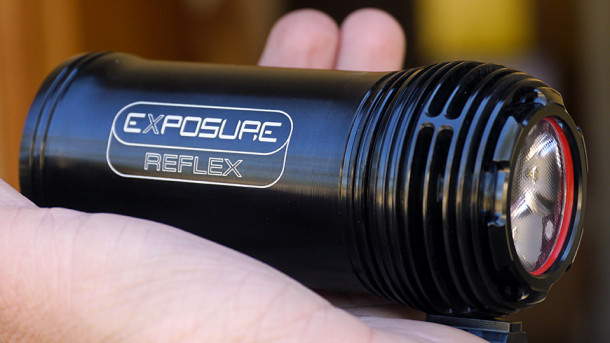
Exposure Reflex Mk1 equals Smaller, Lighter, Brighter, Smarter Lights
Prior to the release of the Reflex, Exposure’s flagship handlebar mounted light was the Six Pack, followed by the MaxX-D. Comparing the three highlights key benefits of Reflex Technology.
| Lumens | Weight | LEDs | Burn Time | Mode Access | |
| Exposure Reflex | 250-2200 | 300grams | 3 XML | 2 – 36 hrs | Auto/Manual |
| Exposure Six Pack | 2000 | 455grams | 6 XPG | 2 – 36 hrs | Manual |
| Exposure MaxX-D | 1600 | 295grams | 4 XPG | 2 – 36 hrs | Manual |
I have all three lights. Prior to the Reflex, I would always chose the MaxX-D over the Six Pack. The MaxX-D’s size and weight is pretty much right on the money for a handlebar mounted light. As mega as the Six Pack is, IMO it’s just too chunky. Post Reflex there is no choice – the Reflex is a next generation light that stands head and shoulders above its siblings. It’s an impressive combination of size, weight, brightness and smarts.
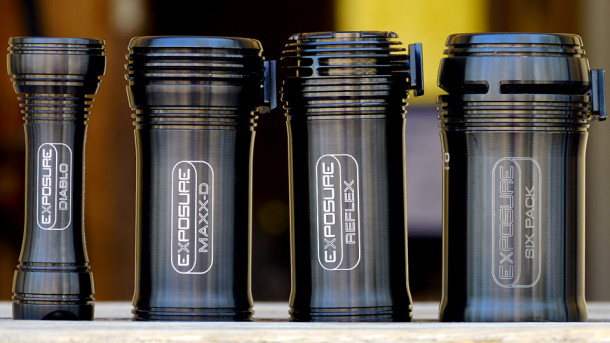
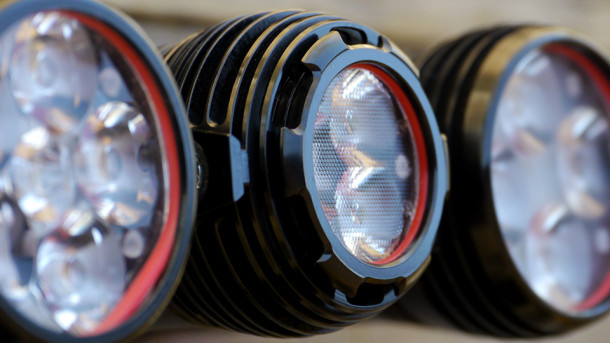
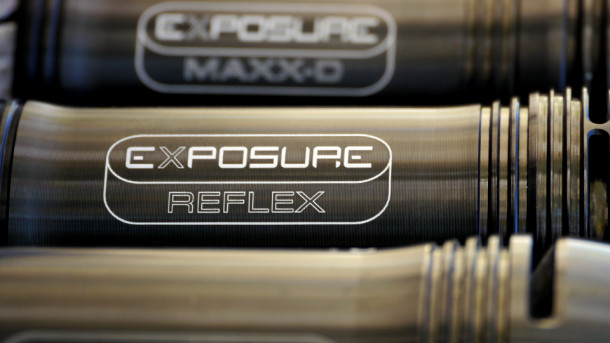
Digital Fuel Gauge
Falling into the category of ‘Why don’t all lights have this?’ is the Reflex’s digital fuel and mode gauge. The live display of remaining output in hours and minutes is an exceptionally cool and useful feature out on the trail. No more guessing if you have enough battery power to make it home or if you need to toggle to a different output mode. The display also provides a user friendly interface for accessing and setting modes, along with indicating the percentage charged when recharging. Cool stuff overall!
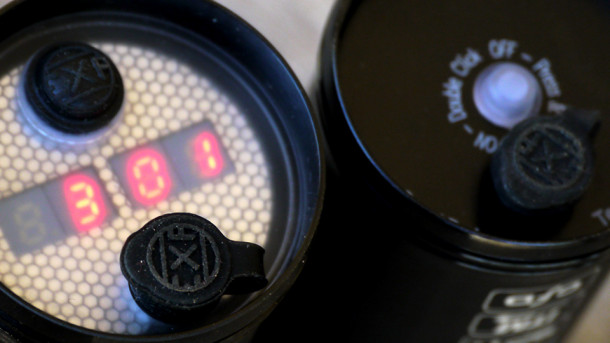
Mounting the Exposure Reflex Mk1
The Reflex mounts to the handlebar using Exposure’s standard Quick Release Handlebar Bracket, compatible with all lights manufactured since 2005. The Quick Release Handlebar Bracket is a neat, unobtrusive system that can be left mounted on the bike.
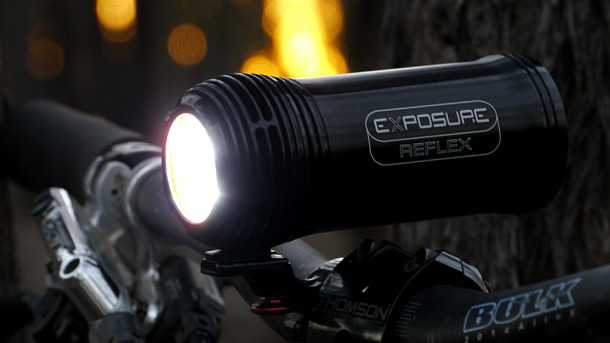
Other Features of the Exposure Reflex Mk1
The Reflex also includes features found on other 2013 Exposure lights including:
- Optimised Mode Selector
OMS allows the rider to manually select from a range of programs to achieve a fixed level of brightness/burn time. - Smart Port Technology Plus (SPT+)
Allows the unit to power additional lights, remote switches and even charge other USB devices such as Smartphones.
(For a full list of Reflex features refer to the Exposure Lights web site.)
Exposure Reflex Mk1 Trail Test
So you can probably tell I’m digging the Reflex but that isn’t because it sounds cool, it’s because of how it performs on the trail.
Straight out of the box (and after an initial charge) I took the Reflex on a 52km solo night ride, from Daylesford to Castlemaine along the Dry Diggings section of the Great Dividing Trail. I’ve ridden the trail quite a few times over the years but never completely at night. The trail features sections of excellent flowing single track along with fire trails, with speeds ranging from 10-50km/h… a perfect test for the Reflex!
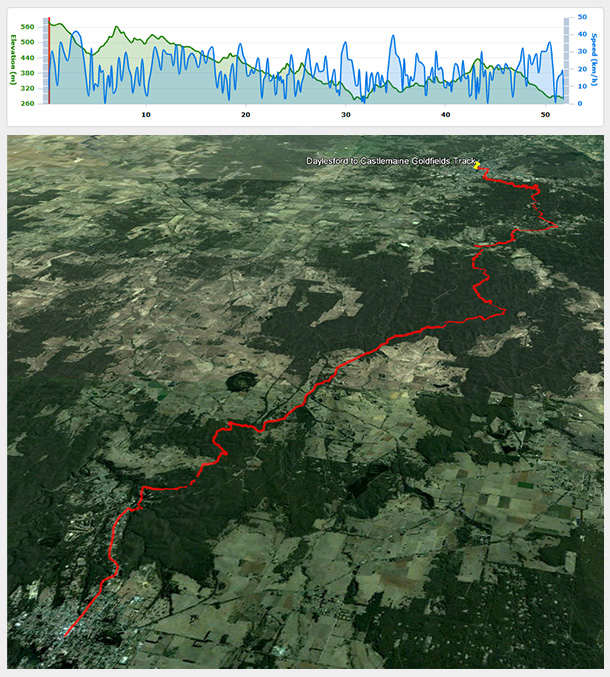
The Reflex offers 3 ‘set and forget’ Auto intelligent modes where the light is aware of speed and gradient and self adjusts output accordingly:
- Auto High ~3 hours @ 2200 Lumens max
- Auto Medium ~6 hours @ 1420 Lumens max
- Auto Low ~12 hours @ 730 Lumens max
I estimated the ride would take between 3-6 hours so opted to run the Reflex in Auto Medium – similar brightness to the MaxX-D at full power but with triple the burn time.
Anyone who does a lot of MTB riding at night knows that regardless of how good a handlebar mounted light is, on its own it isn’t sufficient. A handlebar mounted light often doesn’t point to where you’re headed next i.e. where your eyes are naturally looking, as helmet mounted lights do. Handlebar and helmet lights also work together to create a better sense of depth and definition of terrain and obstacles. I opted to run dual helmet mounted Diablo Mk4’s on Medium mode (~770 Lumens per light), with both being topped up by a Triple Cell Piggyback yielding an estimated burn time of over 7.5 hours. (Check out my review of the Diablo Mk4 here!)

On the trail the performance of the Reflex in Auto mode is seamless. In fact while you are riding the variation in brightness takes place so smoothly you quickly forget about it and get on with riding. It is however eerie but cool to watch the light gradually power itself down during a trail side stop, then power up again as you get going.
At the start of the ride the fuel gauge indicated a burn time of 6 hr 3 min. At the end of the 4 hr 3 min adventure (3 hr 15 min riding) the fuel gauge indicated 2 hr 48 min burn time remaining. That’s an apt illustration of the energy preserving nature of the Reflex, especially considering the light was left in Auto Medium for the entire ride.
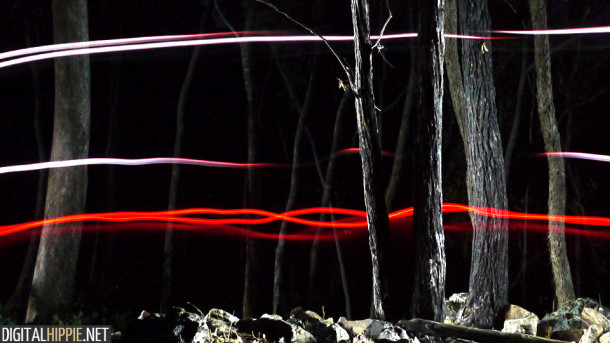
Digital Hippie’s Verdict
The Exposure Reflex is a game changer. Expect to see Reflex’s self adjusting technology and digital fuel gauge trickle down Exposure’s line up and also be imitated by other bike light companies. The future belongs to smaller, lighter, brighter, smarter lights. Reflex is definitely one way to get there… and it’s available today!
Special thanks to BikeBox Australia for the opportunity to review the Exposure Reflex Mk1.
Hi I also have reflex mk1 light but mines doesn’t power down when I stop I have tried all 3 modes can you help. How long did you have to wait before it started to dim when stationary ? Any help would be grateful.
Hi Colin tricky to say but it could be that you have inadvertently ended up in one of the non auto modes that don’t power down versus, but I guess you have checked that.
You don’t really notice the powering down with your eye as you ride – but say if you come a standstill at the bottom of a prolonged fast descent and take note of the area the light is illuminating. Look back after a few minutes and it will be distinctly less.
If all else fails, contact Exposure I reckon.